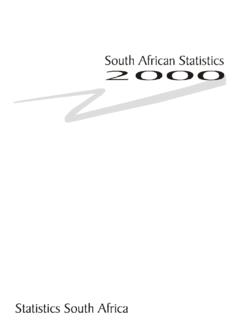Transcription of Quarterly employment statistics - statssa.gov.za
1 T +27 12 310 8911 F +27 12 310 8500 Private Bag X44, Pretoria, 0001, South Africa ISIbalo House, Koch Street, Salvokop, Pretoria, 0002 STATISTICAL RELEASE P0277 Quarterly employment statistics March 2018 Embargoed until: 26 June 2018 11:30 ENQUIRIES: FORTHCOMING ISSUE: EXPECTED RELEASE DATE User information Services June 2018 26 September 2018 Tel:(012) 310 8600/4892/8390 statistics South Africa 2 P0277 Quarterly employment statistics , March 2018 Contents .. Page Introduction .. 3 Key findings: employment and earnings for the quarter ending March 2018 .. 3 Figure A: employment in the non-agricultural formal sector, June 2015 March 2018.. 3 Table A: employment by industry .. 3 Figure B: Gross earnings of employees in the formal non-agricultural sector, June 2015 March 2018.
2 4 Table B: Gross earnings by industry .. 4 Average monthly earnings .. 5 Table C: Average monthly earnings paid to employees in the formal non-agricultural sector .. 5 Key differences between the Quarterly labour force survey (QLFS) and the Quarterly employment survey (QES) .. 5 Part 1 Estimation of number of employees and their earnings .. 9 Table 1 - Total (all formal non-agricultural industries) .. 9 Table 2 - Mining and quarrying industry .. 10 Table 3 - Manufacturing industry .. 11 Table 4 - Electricity, gas and water supply industry .. 12 Table 5 - Construction industry .. 13 Table 6 - Wholesale and retail trade; repair of motor vehicles, motor cycles and personal and household goods; hotels and restaurants industry .. 14 Table 7 - Transport, storage and communication industry.
3 15 Table 8 - Financial intermediation, insurance, real estate and business services industry .. 16 Table 9 - Community, social and personal services industry .. 17 Part 2 Estimation of average monthly earnings .. 18 Table 1 Average monthly earnings at current prices, by industry .. 18 Table 2 Average monthly earnings at constant prices (Dec 2016=100), by industry .. 23 Additional information .. 28 Technical notes .. 28 Table D: Estimates of number of employees by industry within 95% confidence limits .. 29 Table E: Estimates of gross earnings (R' 000) by industry within 95% confidence limits .. 29 Table F: Estimates of average monthly earnings, including bonuses and overtime payments, at current prices, by industry within 95% confidence limits .. 30 Table G: Estimates of average monthly earnings, excluding bonuses and overtime payments, at current prices, by industry within 95% confidence limits.
4 30 Glossary .. 34 General information .. 37 statistics South Africa 3 P0277 Quarterly employment statistics , March 2018 Introduction The Quarterly employment statistics (QES) is an enterprise-based sample survey conducted by statistics South Africa (Stats SA). The samples are drawn from private non-agricultural businesses such as factories, firms, offices, and stores, as well as from national, provincial and local government entities. The definition of industries is based on the System of National Accounts (SNA) and is in line with Standard Industrial Classification of all Economic Activities (SIC), Fifth Edition, Report No. 09-09-02 of January 1993. This survey covers employment statistics of the following industries: mining and quarrying; manufacturing; electricity, gas and water supply; construction; wholesale and retail trade; repair of motor vehicles, motor cycles and personal and household goods; and hotels and restaurants; transport, storage and communication; financial intermediation, insurance, real estate and business services; and community, social and personal services.
5 Key findings: employment and earnings for the quarter ending March 2018 Figure A: employment in the non-agricultural formal sector, June 2015 March 2018. *Revised estimates Table A: employment by industry (thousand) Industry Mar 2017 Dec* 2017 Mar 2018 Q/Q Change Q/Q Change Y/Y Change Y/Y Change % % Mining 464 457 450 -7 -1,5 -14 -3,0 Manufacturing 1 203 1 190 1 199 9 0,8 -4 -0,3 Electricity 63 63 63 0 0,0 0 0,0 Construction 631 598 610 12 2,0 -21 -3,3 Trade 2 103 2 153 2 127 -26 -1,2 24 1,1 Transport 470 468 465 -3 -0,6 -5 -1,1 Business services 2 220 2 232 2 236 4 0,2 16 0,7 Community services 2 610 2 621 2 688 67 2,6 78 3,0 Total 9 764 9 782 9 838 56 0,6 74 0,8 *Revised estimates 9 000 0009 100 0009 200 0009 300 0009 400 0009 500 0009 600 0009 700 0009 800 0009 900 000J U NSEPD E CM A RJ U NSEPD E CM A RJ U NSEPD E C *M A R2015201620172018E M P L O Y M E N TStatistics South Africa 4 P0277 Quarterly employment statistics .
6 March 2018 Table A shows that employment increased by 56 000 quarter-on-quarter, from 9 782 000 in December 2017 to 9 838 000 in March 2018. This was largely due to increases in the following industries: community services (67 000 or 2,6%), construction (12 000 or 2,0%), manufacturing (9 000 or 0,8%) and business services (4 000 or 0,2%). The electricity industry remained unchanged. However there were decreases in the following industries: trade (-26 000 or -1,2%), mining and quarrying (-7 000 or -1,5%), and transport (-3 000 or -0,6%). employment increased by 74 000 or 0,8% year-on-year between March 2017 and March 2018. These increases were reported by: community services (78 000 or 3,0%) , trade (24 000 or 1,1%) and business services (16 000 or 0,7%).
7 The electricity industry remained unchanged. The following industries reported annual decreases: construction (-21 000 or -3,3%), mining and quarrying (-14 000 or -3,0%), transport (-5 000 or -1,1%) and manufacturing (-4 000 or -0,3%). Figure B: Gross earnings of employees in the formal non-agricultural sector, June 2015 March 2018 *Revised estimates Table B: Gross earnings by industry (R million) Industry Mar 2017 Dec* 2017 Mar 2018 Q/Q Change Q/Q Change Y/Y Change Y/Y Change % % Mining 30 954 32 437 32 132 -305 -0,9 1 178 3,8 Manufacturing 62 836 71 950 65 149 -6 801 -9,5 2 313 3,7 Electricity 7 481 9 287 7 953 -1 334 -14,4 472 6,3 Construction 27 987 32 463 27 684 -4 779 -14,7 -303 -1,1 Trade 86 772 98 561 91 679 -6 882 -7,0 4 907 5,7 Transport 33 335 37 894 34 355 -3 539 -9,3 1 020 3,1 Business services 188 155 166 388 172 660 6 272 3,8 -15 495 -8,2 Community services 188 578 209 917 201 660 -8 257 -3,9 13 082 6,9 Total 626 098 658 897 633 272 -25 625 -3,9 7 174 1,1 *Revised estimates Table B shows that gross earnings paid to employees decreased by R25 625 million (-3,9%)
8 From R658 897 million in December 2017 to R633 272 million in March 2018. The decrease was mainly due to decreases in community services; trade; manufacturing; construction; transport; electricity and mining and quarrying industries. There was an increase reported by the business services industry. R 400 000R 450 000R 500 000R 550 000R 600 000R 650 000R 700 000J U NSEPD E CM A RJ U NSEPD E CM A RJ U NSEPD E C *M A R2015201620172018 MILLIONSG R O S S E A R N I N G SStatistics South Africa 5 P0277 Quarterly employment statistics , March 2018 Year-on-year, gross earnings increased by R7 174 million (1,1%). Average monthly earnings Table C: Average monthly earnings paid to employees in the formal non-agricultural sector Average monthly earnings (including bonuses and overtime payments) Feb 2017 Nov 2017* Feb 2018 Q/Q Change Y/Y Change Rands % 18 913 20 060 19 858 -1,0 5,0 *Revised estimates Table C shows a quarter-on-quarter decrease of 1,0% in average monthly earnings paid to employees in the formal non-agricultural sector from R20 060 in November 2017 to R19 858 in February 2018.
9 Key differences between the Quarterly labour force survey (QLFS) and the Quarterly employment survey (QES) There are two official sources of employment statistics , the QES which is establishment based and the QLFS which is household based. Each survey has its strengths and limitations. For example, the QES cannot provide information on the following; Description of the employed their demographic profile, education level, hours of work etc.; and Unemployment and descriptors of the unemployed. The Quarterly labour force survey (QLFS) is a survey of households which collects information from approximately 30 000 dwelling units, and collects data on the labour market activities of individuals; whereas Quarterly employment statistics (QES) is an enterprise based survey that collects information from non-agricultural businesses and organisations from approximately 20 000 units.
10 The numerous conceptual and methodological differences between the household and enterprise based surveys result in important distinctions in the employment estimates derived from the surveys. Among these are: The household survey includes agricultural workers, self-employed workers whose businesses are unincorporated, unpaid family workers, and private household workers among the employed. These groups are excluded from the enterprise based survey. The household survey is limited to workers 15 years of age and older. The enterprise based survey is not limited by age. The household survey has no duplication of individuals, because individuals are counted only once, even if they hold more than one job. In the enterprise based survey, employees working at more than one job and thus appearing on more than one payroll are counted separately for each appearance.















